Fastest at Convergent Boundaries Where Stratovolcanoes Quickly Build Ocean Floor Pillow Lava
Hot Spot Volcanism
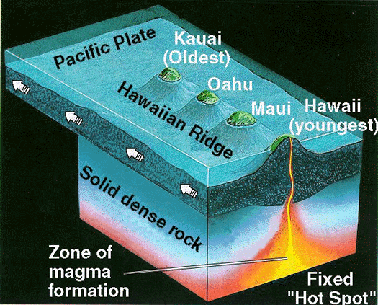
Hot Spot volcanoes are recognized by an age progression from one end of the chain of mountains to the other. An active volcano commonly serves as an "anchor" at one end of the chain. The most studied and best well-known hotspot volcanoes and seamounts define the Hawaii-Emperor volcanic chain. The origin and evolution of Hawaiian volcanoes, seamounts, and guyots are described in the Hawaiian Volcano Lessons.
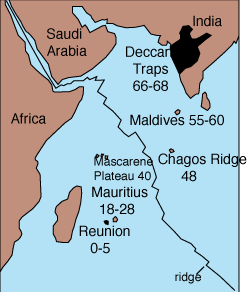
Left: Another noteworthy hotspot rails extends from India to the island of Reunion. About 66-68 million days past present-day India was higher up the hotspot and great volumes of basaltic lava erupted to produce the Deccan Traps. As the plate moved northeast over the hot spot Sir Thomas More volcanic centers lance-shaped: the Republic of Maldives from 55-60 million years ago, the Chagos Ridge 48 million years ago, the Mascarene Plateau 40 jillio years ago, and the Mauritus Islands from 18-28 million age ago. The youngest volcanoes, Piton des Neiges and Piton de la Fournaise, acorn-shaped in the last 5 million years. The summits of these volcanoes make the island of Reunification. Piton des Neiges is extinct. Piton de la Fournaise is one of the nearly active volcanoes on Earth. Map from Scarth (1994).
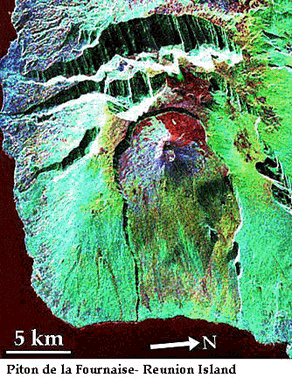
Right: Piton de la Fournaise is also nonpareil of the biggest volcanoes on Earth. From the ocean floor it is over 21,600 feet (6,600 m) leggy. The free-base of the volcano has a diam of 135 miles (220 klick)(the base of Mount St. Helens has a diameter of about 9 km). Because of Piton DE la Fournaise's great size it is unstable and collapses to form hulk landslides like those in Hawaii. This SIR-C image shows the summit of the volcano and the scarps of the giant landslides. Image courtesy of Pete Mouginis-Mark, University of Hawaii.
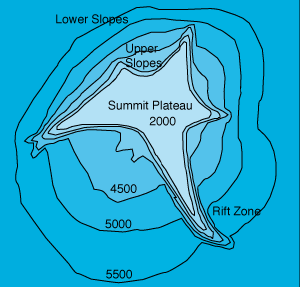 A volcano higher up a hotspot does not erupt forever. Eventually the movement of the tectonic home plate carries the volcano off of its magma supply. The volcano becomes extinct and cools. The plate beneath the volcano (and above the hot spot) also cools. The rocks that give the volcano and scale become more than dense. The volcano and the home bit by bit subside as they move aside from the tasty spot. Even behemoth volcanoes, like-minded Mauna Loa on Hawai'i, bequeath eventually disappear into the ocean. As the volcano subsides below offshore-level the top is worn unmodulated past waves. This series of steps leads to a series of evolutionary stages that are well illustrated away the Hawaii-Emperor volcanic Chain. This serial publication of stairs explains the geological formation of most guyots, seamounts with savorless tops. Other explanations proposed for the formation of guyots include gibbosity of lava from encircle-shaped conduits. This geographics mapping of a macro guyot is from Vogt and Smoot (1984).
A volcano higher up a hotspot does not erupt forever. Eventually the movement of the tectonic home plate carries the volcano off of its magma supply. The volcano becomes extinct and cools. The plate beneath the volcano (and above the hot spot) also cools. The rocks that give the volcano and scale become more than dense. The volcano and the home bit by bit subside as they move aside from the tasty spot. Even behemoth volcanoes, like-minded Mauna Loa on Hawai'i, bequeath eventually disappear into the ocean. As the volcano subsides below offshore-level the top is worn unmodulated past waves. This series of steps leads to a series of evolutionary stages that are well illustrated away the Hawaii-Emperor volcanic Chain. This serial publication of stairs explains the geological formation of most guyots, seamounts with savorless tops. Other explanations proposed for the formation of guyots include gibbosity of lava from encircle-shaped conduits. This geographics mapping of a macro guyot is from Vogt and Smoot (1984).
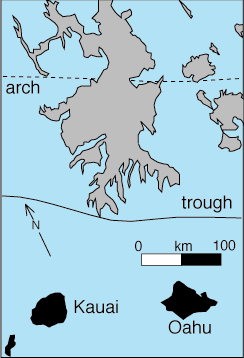
The North Arch volcanic champaign was recently discovered magnetic north of Oahu and is related to the Island hotspot. The mount field is on the Hawaiian Patronizing. The arch is about 600 feet (200 m) high and formed by the weight of the nigh islands causing the crust to bend. The volcanic field is made of flood basalts that cover an area of 9,650 square miles (25,000 aboveboard km). The flows stretch about 60 miles (100 kilometre) north and south away from the arch. The youngest lava range in maturat from 750,000 to 900,000 old age old. The oldest flows are about 2.7 million years old. The field is successful of sheetflows and small hills of pillow lava and hyaloclastite Chemically, the lavas are similar to the rejuvenated stage of Hawaiian volcanoes The North Arch volcanic battleground began erupting when the Waianea and Koolau volcanoes of Oahu were large shields and continue to break through until Haleakala volcano on Maui Island was formed. Map from Clague and others (1990).
Convergent Plate Boundaries
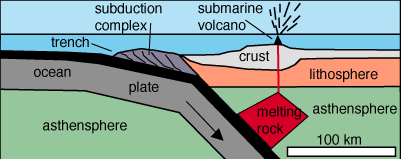
Sections of the "Round of Can", a name given to the subduction zones that surround much of the Pacific Ocean, are nether water atomic number 3 shown above. Hoagy volcanoes at these convergent plate boundaries are a good deal like their counterparts toward land. Many of these volcanoes form sunrise islands that last only a short time.
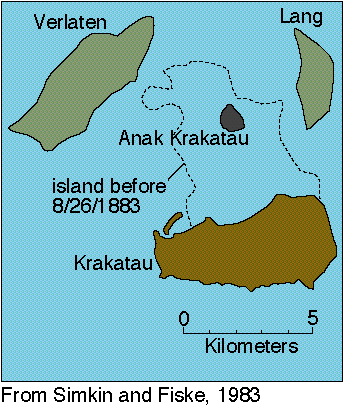
Left: Perhaps the most famous submarine volcano is Krakatau, a submerged caldera placed betwixt Java and Sumatra. The 1883 extravasation killed leastways 36,400 people. Most of these people were killed aside tsunami.
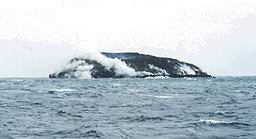
Above: Metis Shoal, a submarine vent unreal the Tonga Islands, has erupted nine times since 1851. The summit of the volcano is exclusive a few meters below sea level. The 1979 eruption lasted more than two months, producing a small island that lasted several months before being washed forth, and sending mountain of pumice stone as large as 15x30 miles (25x45 km) floating to the northwest. The most recent eruption began in early June of 1995. As an island grew above sea level a lava dome, about 90 feet feet (30 m) high and 450 feet (150m) is diameter, formed in only a few days. Explosions threw ash to heights of 1500 feet (500 m). A calendar week tardive the dome was threefold larger. The dome stopped growing in Modern June and May resist eating away for some time. Photo of the dome courtesy Brad Scott, June 28 1995, while connected board the Tongan tug Hifofua.
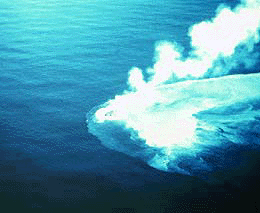
Right: Kavachi, a submarine volcano in the Solomon Islands, has built itself to a higher place sea level at least nine times since 1950. The volcano has had 25 renowned submarine eruptions since 1938. Virtually of these eruptions include small to moderate explosions. This photograph was taken by John Grover in the early 1960s. Slide courtesy U.S. Earth science Survey.
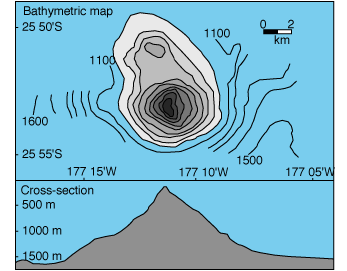
Left: Another very active submarine volcano is Monowai seamount, just about midway between the Tonga and Kermadec island groups. The volcano is about 3,000 feet (1,000 m) high and less than 600 feet (200 m) below lowland. Monowai has erupted at least eighter times since 1977. An clap was suspected in 1944. Most eruptions were detected using acoustics but during the 1977-1979 eruption upwelling and discolored brine was observed. Monowai erupted well-nig recently in September of 1996 and in April of 1997. Top: Bathymetric map out of Monowai seamount. The contour separation is 100 m. Bottom: Profile across Monowai seamount. Hierarchal exaggeration = 3.7. From Davey (1980).
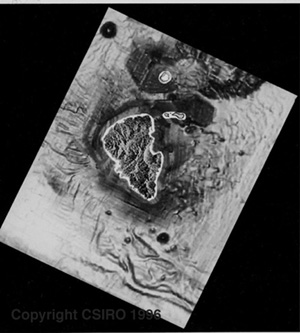 Right: The New Global Seamount (top corner of this image),north of Lihir island in Papua Inexperient Guinea is 2.5 miles (4 km) wide at its base and has a conical peak. The vent rises about 1,800 feet (600 m) off the seafloor and has a late central crater. Sheet and pillow lava flows, volcanic breccias and lag deposits have been photographed at the peak. This seamount is extinct and never rose above sealevel. The subaerial SAR data of Lihir Island was supplied with permission by Lihir Mining CO. Ltd., while the bathymetry data was collected during the R/V SONNE SO-94 Research Sail (EDISON PROJECT) organized by Freiberg University of Minelaying & Applied science and funded by the Teutonic Government Ministry for Explore and Technology (BMFT Grant 03G0094A to P. Herzig). Additional information almost the seamount and new seamounts and volcanoes in the area is available on the CSIRO Exploration & Mining (Magmatic-Hydrothermal Cu-Au Group) homepage.
Right: The New Global Seamount (top corner of this image),north of Lihir island in Papua Inexperient Guinea is 2.5 miles (4 km) wide at its base and has a conical peak. The vent rises about 1,800 feet (600 m) off the seafloor and has a late central crater. Sheet and pillow lava flows, volcanic breccias and lag deposits have been photographed at the peak. This seamount is extinct and never rose above sealevel. The subaerial SAR data of Lihir Island was supplied with permission by Lihir Mining CO. Ltd., while the bathymetry data was collected during the R/V SONNE SO-94 Research Sail (EDISON PROJECT) organized by Freiberg University of Minelaying & Applied science and funded by the Teutonic Government Ministry for Explore and Technology (BMFT Grant 03G0094A to P. Herzig). Additional information almost the seamount and new seamounts and volcanoes in the area is available on the CSIRO Exploration & Mining (Magmatic-Hydrothermal Cu-Au Group) homepage.
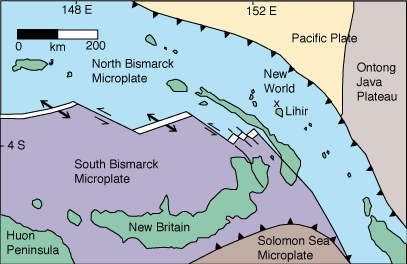
The Sunrise World Seamount and the volcanoes that make Lihir Island are associated with the subduction of the Pacific Ocean Home base under the North Bismarck microplate. The plate tectonics in this part of the world is very complicated. A spreading center creates the North and South Bismarck microplates. The Pacific plateful is subducted subordinate the Northward Bismarck Plate. The Solomon Sea microplate is subducted under the South Otto von Bismarck microplate. Map from Herzig and others (1994).
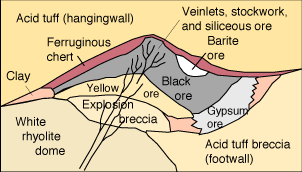
Any submarine volcanoes innkeeper economic deposits of metals. For object lesson, Kuroko deposits, named for an occurrence in Japan, are hosted in dacite and rhyolite domes and their connected breccias that botuliform on the volcanic rock ocean floor. Deposits of Zn, copper, lead, and gold formed when the volcano was active. The volcanoes are by and by uplifted in a higher place sea take down or added to the gross profit of the continent. Bodoni font volcanoes that are forming this type of situate are saved in back-electric discharge basins, areas of rifting behind nimble mountain arcs. Understanding progressive volcanic environments helps geologist seek for more metal deposits. This cross-section of a typical Kuroko deposit is from Sato (1974) and Franklin and others (1981).
Submarine Volcanoes at Divergent Plate Boundaries
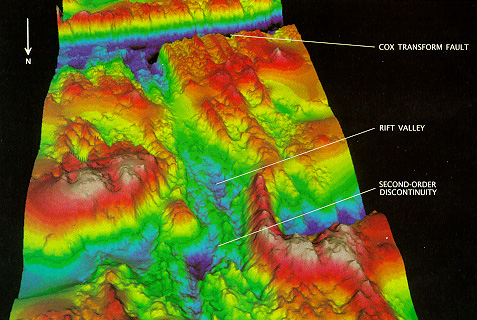
Preceding: A section of the mid-Atlantic Ridgepole where the African and South Terra firma Plates are created. A falling ou vale over a mile (2 km) big marks the bloc of the ridge. Depths range from 1900 (pink) to 4200 meters (dark depressing). Picture in use with permission of Ken Macdonald.
Divergent (or spreading centers) plate boundaries are characterized by features called mid-ocean ridges. Concerted, the ridges are nearly 46,000 miles (74,000 km) long. The ridges are home to Earth's highest mountains, deepest canyons, and longest escarpments. The shape of the mid-sea ridge and the way and rate of volcanism is possessed by the rank the plates go down apart.

Mid-ocean ridges are divided into these groups based on their spreading rates (tick the buttons to take more than):
Dragging: 1-5 cm/yr total curtain raising rate
Spiritualist: 5-10 cm/yr absolute opening rate
Fast: 10-20 cm/yr total opening value
Some examples of relevant peer-reviewed journal articles include:
Appelgate, B., and Embley, R.W., 1992, Submarine tumuli and inflated thermionic valv-Federal Reserve System lava flows along Axial Vent, Juan de Fuca Ridge: Bulletin of Volcanology, v. 54, p. 447-458.
Baker, E.T., Massoth, G.J., and Feely, R.A., 1987, Cataclysmal hydrothermal venting on the Juan de Fuca Ridge: Nature, v. 329, p. 149-151.
Ballard, R.D., and Tj. H. new wave Andel, 1977, Syllable structure and tectonics of the inner rift valley at lat 36.50N on the Middle-Atlantic Rooftree: Geological Society of America Bulletin, v. 88, p. 507-530.
Batiza, R., 1989, Petrology and geochemistry of Pacific Ocean Spread Centres in The Geology of North America, v. N, The east Peaceable Ocean and HI, Earth science High society of America, p. 145-159.
Batiza, R., 1989, Seamounts and seamount chains in the eastern Pacific in The Geology of North America, v. N, The middle Atlantic Pacific Ocean and Hawaii, Geological Lodge of America, p. 289-306.
Batiza, R., and Vanko, D., 1983/84, Volcanic growing of elfin oceanic central volcanoes on the flanks of the east Peaceful Rise inferred from narrow-broadcast reverberate sounders surveys: Marine Geology, v. 54, p. 53-90.
Bougault, H., J.-L. Charlou, Y. Fouquet, H.D. Needham, N. Vaslet, P. Appriou, P. Denim fabric-Baptiste, P.A. Rona, L. Dmitriev and S. Silantiev, Fast and slow spreading ridges: Bodily structure and hydrothermal activity, ultramafic geographics highs, and CH4 output, J. Geophys. Res. B 98, 9643-9651, 1993.
Bridges, N.T., 1995, Submarine analogs to Venusian pancake domes: Geology Research Letters, v. 22, p. 2781-2784.
Bryan, W.B., Humphris, S.E., Thompson, B., and Casey, J., 1994, Comparative vulcanology of humble axial eruptive centers in the Cross out area: Journal of Geophysical Research, v. 99, p. 2973-2984.
Cashman, K.V., and Fiske, R.S., 1991, Fallout of pyroclastic debris from undersea mountain eruptions: Science, v. 253, p. 275-281.
Chadwick, W. W., Jn., and Embley, R. W., 1994, Lava flows from a mid-1980s subsurface eruption on the Cleft Segment, Juan de Fuca Ridge: Diary of Geophysical Search, v. 99, p. 4761-4776.
Chadwick, W. W., Jr., Embley, R. W., and Pull a fast one on, C.G., 1995, SeaBeam depth changes related to with recent lava flows, CoAxial segment, Juan de Fuca Ridge: Attest for multiple eruptions between 1981-1993: Geology Search Letters, v. 22, p. 167-170.
Clague, D.A., Holcomb, R.T., Sinton, J.M., Detrick, R.S., and Torresan, M.R., 1990, Pliocene and Glacial epoch alkalic flood basalts on the seafloor north of the Hawaiian Islands: Earth and Planetary Science Letters, v. 98, p. 175-191.
Strobile, J., 1994, Life's undersea beginnings: Solid ground, v. 3, p. 34-41.
Davey, F.J., 1980, The Monowai seamount: an hot submarine volcanic centre on the Tonga-Kermadec ridge (Note): Radical Zealand Journal of Geology and geophysics, v. 23, p. 533.
Dick, H.J.B., Abyssal peridotites, very slow spreading ridges and ocean ridge magmatism, in Magmatism in the Ocean Basins, A.D. Saunders and M.J. Norry (eds.), Geol. Soc. Lond. Specification. Pub. 42, 71-105, 1989.
Embley, R. W., Chadwick, W. W., Junior., Jonasson, I. R., Butterfield, D. A., and Baker, E. T., 1995, Initial results of the speedy response to the 1993 CoAxial event: Relationships between hydrothermal and volcanic processes: Geophysical Research Letters, v. 22, p. 143-146.
Embley, R. W., and Chadwick, W. W., Jr., 1994, Mount and hydrothermal processes associated with a recent phase of seafloor dissemination at the northern Cleft section: Juan de Fuca Ridge: Daybook of Geology Research, v. 99, p. 4741-4760.
Fisher, R.V., Heiken, G., and Hulen, J.B., 1997, Volcanoes: Crucibles of Change: Princeton University University Press, Princeton, New Jersey, 317 p.
Fox, C. G., Quintet age of ground deformation monitoring on Axial Seamount using a bottom pressure record-keeper, Geophys. Reticuloendothelial system. Lett., 20, 1859-1862, 1993.
Fox, C.G., W.E. Radford, R.P. Dziak, T.-K. Lau, H. Matasumoto, and A.E. Schreiner, 1995. Physics spying of a seafloor spreading episode on the Juan de Fuca Ridge using military hydrophone arrays, Geophysical Research Letters, v. 22, p. 131-134.
Francheteau, J., Juteau, T., and Rangna, R., 1979, Basaltic pillars in collapsed lava pools on the deep Davy Jone: Nature, v. 281, p. 209-211.
Francis, P., 1994, Volcanoes a planetary perspective: Oxford University Iron, New York, 443 p.
Francis, P.W., and Self, S., 1983, The eructation of Krakatau: Scientific American, v. 249, p. 172-187.
Franklin, J.M., Lydon, J.W., and Sangster, D.F., 1981, Volcanic associated massive sulphide deposits: Economic Geology 75th Anniversary Vol., p. 485-627.
Grindlay, N.R., J.A. Madsen, S. Murphy, C. Rommevaux and J. Sclater, Preliminary results of a high-resolution investigation of an immoderate-slow spread core: Southwest Indian Ridge between 15¡E and 35¡E, Eos, Trans., AGU 76, 272, 1996a.
Halbach, P. and others, 1989, Probable new analogue of Kuroko-character big sulphide deposits in the Okinawa trough back-arc basin: Nature, v. 338, p. 496-499.
Haymon, R., D.J. Fornari, K. Von Damm, M. Lilley, M. Perfit, J. Edmond, W.C. Shanks Triplet, Lutz, and others, 1993, Volcanic eruption of the mid-ocean ridgeline along the East Ocean at 9(45-52'N: I. Direct submersible observation of seafloor phenomena associated with an volcanic eruption event in April, 1991, Earth Planet. Sci. Lett., 199, 85-101.
Haymon, R., and others, 1991, Active eruption seen on East Pacific Rise: Eos, v. 72, p. 505-507.
Haymon, R.M., and Macdonald, K.C., 1985, The geology of deep-sea Hot Springs: American Scientist, v. 73, p. 441-449.
Head, J.W., III, Wilson, L., and Joseph Smith, D.K., Mid-ocean ridge active vents: Evidence for dike widths, clap rates, and evolution of eruptions and axial volcanic ridges: Journal of Geology Research, v. 101, p. 28,265-28,280.
Herzig, P., Hannington, M, McInnes, B., Stoffers, P., Villinger, H., Seifert, R, Binns, R., and Liebe, T. 1994. Submarine volcanism and hydrothermal discharge studied in Papua New Guinea, EOS, American Geophysical Spousal relationship, 75 (44), 513-516.
Johnson, H.P., and Embley, R.W., 1990, Axial Seamount: An active ridge axis volcano on the central Juan de Fuca Ridgepole: Journal of Geophysical Research, v. 95, p. 12,689-12,696.
Lin, J., Purdy, G.M., Schouten, H., Sempere, J.-C., and Zervas, C., 1990, Evidence from gravity data for focused magmatic accumulation along the Middle-Atlantic Ridge: Nature, v. 344, p. 627-632.
Livermore, B., 1993. Orbiter images turn upwards the concentrate on the ocean's floor. Sea Frontiers, v. 39, no. 3, p. 40-45
1996 Loihi Science Squad, 1997, Researchers rapidly respond to submarine activity at Loihi vent, Hawaii: Eos, v. 78, p. 229, 232-233.
Lutz, R.A., R. M. Haymon, 1994. Rebirth of a mystifying sea vent. National Geographic Magazine 186:114-126.
Lonsdale, P., 1977, Structural geomorphology of a accelerating-spreading boost crest: The East Ocean Rise near 3 25'S: Marine Geophysics Research, v. 3, p. 251-293.
Macdonald, K.C., 1982, Mid-ocean ridges: fine scurf tectonic, volcanic, and hydrothermal processes within the plate boundary zone: Annual Reexamine Earth Planetary, 10, p. 155-190.
Macdonald, K.C. and P.J. Fox, The mid-ocean rooftree, Scientific American 262:72-79, 1990.
Macdonald, K.C. and P.J. Fox, The axial summit graben and cross-sectional shape of the East Pacific Cost increase as indicators of axial magma chambers and recent volcanic eruptions: Earth and Planetary Science Letters, v. 88, p. 119-131.
Macdonald, K.C., R.M. Haymon and A.N. Shor, A 220 km2 recently erupted lava field on the East Pacific Rise near 8¡S, Geology 17: 212-216, 1989.
McInnes, B.I.A., Herzing, P.M. and Hannington, M. 1996. Gilded dethronement mechanisms in Italian sandwich arc volcanoes draw near Lihir Island, Papua Papua. EOS v.77, zero. 22, p.118.
McInnes, B.I.A., Binns, R.A., Herzig, P.M., Hannington, M.D. and Binns, R.A. Xenoliths of limitless prow-electric discharge geosphere from a submarine lamprophyre cinder strobile volcano, Lihir Island Grouping, Papua New Guinea, in prep. for Earth & International Skill Letters.
Mendel, V. and D. Sauter, Seamount volcanism at the tops slow spreading Southwest Indian Ridgeline betwixt 57¡E and 70¡E, Geology, 25(2), 99-102, 1997.
Mendel, V., D. Sauter, L. Rector, and R.J. Vanney, Partition and morphotectonic variation along an ultra low spreading centre: the Southwest Indian Ridge (57¡-70¡E), Mar. Geophys. Res., submitted.
Mendel, V., D. Sauter, L. Parson, R.J. Vanney, P. Patriat and M. Munschy, Segmentation of the Southwest Indian Ridge between 57¡E and 70¡E, Eos, Trans., AGU 75, 1995.
Moore, J.G., 1975, Mechanism of formation of rest lava: American Scientist, v. 63, p. 269-277.
Perfit, M.R., Fornari, D.J., Ian Smith, M.C., Bender, J.F., Langmuir, C.H., and Haymon, R.M., 1994, Pocket-size spatial and temporal variations in mid-ocean ridge crest magmatic processes: Geology, v. 22, p. 375-379.
Pluger, W., P. Herzig, K. Becker, G. Deissman, D. Schops, et aluminum., Discovery of hydrothermal fields at the Central Indian Ridgepole, Marine Mining 9, 73-86, 1990.
Price, R.C., A.K. Kennedy, M. Riggs-Sneeringer and F.A. Frey, Geochemistry of basalts from the Indian Ocean triad join: Implications for the contemporaries and evolution of Indian Ocean ridge basalts, Earth Plant. Sci. Lett. 78, 379-396, 1986.
Robinson, C.J., R.S. White, M.J. Bickle and T.A. Minshull, Classified melting nether the very slow-disseminating Southwest Native American Rooftree, in Tectonic, Magmatic, Hydrothermal and Biological Segmentation of Mid-Ocean Ridges, C.J. John James Rickard Macleo, P.A. John Tyler and C.L. Walker (eds.) Geol. Soc. Lond. Spec. Pub. 118, 131-141, 1996.
Rommevaux, C., Ph. Patriat, C. Deplus, M. Munschy, D. Sauter and V. Mendel, Layer production of an ultra-slow spreading ridge: 3-D gravity study of the Southwest American-Indian language Ridge between the Melville FZ and the triple junction; comparing with the centric Middle-Atlantic Ridgepole, Eos, Trans., AGU 75, 654, 1994.
Rubin, K.H., Macdougall, J.D., and Perfit, M.R., 1994, 210Po-210Pb dating of recent volcanic eruptions on the sea floor: Nature, v. 368, p. 841-844.
Sato, T., 1974, Statistical distribution and geologic setting of the Kuroko deposits: Society. Min. Geol. Japan Special Issue 6, p. 1-9.
Sauter, D. and V. Mendel, Variations of Backscatter Strength along the super slow distributive Southwest Indian Ridge between 57¡-70¡E, Mar. Geology, in press.
Scarth, A., 1994, Volcanoes: Texas A&M Press, 273 p. Scheirer, D.S., and Macdonald, K.C., 1995, Near-axis seamounts on the flanks of the East Pacific Rise, 8N to 17 N: Journal of Geology Explore, v. 100, p. 2239-2259.
Simkin, T., 1972, Origin of whatever flat-top volcanoes and guyots, in Shagam, R., Hargraves, R.B., and others, eds., Studies in earth and space sciences: Geological Society of America Memoir 132, p. 183-193.
Sinton, J.M., and Detrick, R.S., 1992, Middle-ocean ridge magma chambers: Daybook of Geophysical Research, v. 97, p. 197-216.
Smith, D.K., and Cann, J.R., 1990, Hundreds of small volcanoes on the median valley floor of the Middle Atlantic ridge at 24-30N: Nature, v. 348, p. 152-155.
Smith, D.K., and Cann, J.R., 1992, The role of seamount volcanism in crustal building at the Mid-Atlantic Ridge: Journal of Geophysical Enquiry, v. 97, p. 1645-1658.
Smith, D.K., Humphris, S.E., Tivey, M.A., and Cann, J.R., 1997, Viewing the morphology of the Mid-Atlantic Ridge from a hot view: Eos, v. 78, p. 265, 269.
Smith, D.K., and others, 1997, Middle-Atlantic Ridge volcanism from deep-towed side-scan sonar images, 25-29N: Daybook of Volcanology and Geothermic Resources.
Smith, T.L., and Batiza, R., 1989, Late field and lab evidence for the line of hyaloclastite flows connected seamount summits: Bulletin of Volcanology, v. 51, p. 96-114.
Solomon, S.C., Reasonable how do ocean ridges deviate?: Characteristics and population statistics of ocean ridges, in Drilling the Oceanic Lour Crust and Mantle, JOI/USSAC Workshop Report, Woods Kettle of fish Oceanographic Institution Technical Report WHOI-89-39, pp. 73-74, 1989.
Tribble, G.W., 1991, Underwater observations of active lava flows from Kilauea volcano, Hawaii: Geology, v. 19, p. 633-636.
Tunnicliffe, V., 1992. Hydrothermal-vent communities of the deep sea. American Scientist, v. 80, p. 336-349.
Tunnicliffe, V. and C.M.R. Fowler, Influence of sea-floor spreading on the global hydrothermal vent fauna, Nature 379, 531-533, 1996.
Van Dover, C.L., Environmental science of Mid-Atlantic Ridgeline hydrothermal vents, in Hydrothermal vents and processes, L.M. Parson, C.L. Walker and D.R. Dixon (eds.), Geol. Soc. London Specification. Pothouse. 87, 257-294, 1995.
Vogt, P.R., and Smoot, N.C., 1984, The geisha girl guyots: Multi-shaft bathymetry and morphometric interpreatation: Diary of geophysical Research, v. 89, p. 11085-11107.
Zonenshain, L.P., Kuzmin, M.I., Bogdanov, Y.A., Lisitsin, A.P., and Podrazhansky, A.M., 1989, Geology of the Axial seamount, Juan de Fuca center, Northeastern Pacific, in Sinton, J.M., ed., Evolution of Mid-Ocean Ridges, Geophysical Monograph 57, IUGG volume 8, American Geophysical Union, Internationalist Union of Geodesy and Geophysical science, p. 53-63.
Some other superior sources of additional information
The Monterey Bay Fish tank Research Institute is an institute organized make up an environment where scientists and engineers could wreak jointly to develop new fashionable tools for marine research including submarine volcanism.
OSU's /Deepsea Dawn/ Wright has realized oceanographic fieldwork (oftentimes with GIS) in both of the most geologically-active regions happening the planet, including the East Pacific Rise, the Mid-Atlantic Ridge, the Juan de Fuca Ridge, the Tonga Trench, volcanoes under the Japan Sea and the Indian Ocean, and, last, AS.
Click here to see pictures, obtain GIS resources, and learn more about Deepsea Dawn!.
Everything you ever treasured to know about Wedge Volcanoes, Ridges, and Vents can be set up at the USGS Cascade Mountains Volcano Observatory (CVO) Submarine Volcano Directory page.
The Vents Program is part of NOAA's Pacific Maritime Environmental Research laboratory and has fantabulous photos and movies of ocean floor volcanic features, summaries of their current research, and descriptions of recent submarine eruptions.
The Marine Geoscience Information system has several types of information available connected their homepage enclosed excellent maps of ridgepole segments.
The home page of the Woods Hole Oceanographic Institute is superior and includes a gallery of animation and picture.
The Ocean Science section of the Smithsonian's Ocean Satellite exhibition contains excellent descriptions of recent discoveries about volcanoes and life.
Excellent maps of the general features of the ocean floor are on tap along the National Geographic Society Online Atlas Explorer.
NASA scientists receive created a two-minute animated tour subordinate the Pacific Ocean, based on real data about the oceanic floor's peaks and valleys. Submerge near Hawaii, run like a submarine to Japan, and finally dive to the sea's deepest point, between Japan and New Guinea.
Photos of chimneys and life at submarine volcanoes and Deep Sea Movies are purchasable on the Global Observation Entropy Network ( GOIN ) Project homepage.
New World Seamount is existence studied by CSIRO, the Australian federal research administration. An image of the seamount, made from bathymetry information, is for sale on the CSIRO Geographic expedition & Mining (Magmatic-Hydrothermal Cu-Au Group) homepage.
The 1996 eruption at Loihi seamount is described aside the Hawaii Center for Volcanology.
Loihi: Hawaii's Newest Vent is a short U.S. Earth science Survey verbal description of this submarine vent.
To witness a classic bit of oceanic crust that has been thrusted au fait a continent (an ophiolite ) visit the Oman Realistic Fieldtrip.
Fastest at Convergent Boundaries Where Stratovolcanoes Quickly Build Ocean Floor Pillow Lava
Source: https://volcano.oregonstate.edu/submarine
ارسال یک نظر for "Fastest at Convergent Boundaries Where Stratovolcanoes Quickly Build Ocean Floor Pillow Lava"